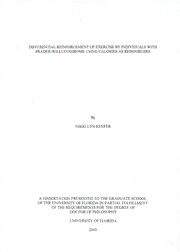Table Of ContentDIFFERENTIALREINFORCEMENTOFEXERCISEBYINDIVIDUALSWITH
PRADER-WILLISYNDROMEUSINGCALORIESASREINFORCERS
By
NIKKILYNKEEFER
ADISSERTATIONPRESENTEDTOTHEGRADUATESCHOOL
OFTHEUNIVERSITYOFFLORIDAINPARTIALFULFILLMENT
OFTHEREQUIREMENTSFORTHEDEGREEOF
DOCTOROFPHILOSOPHY
UNIVERSITYOFFLORIDA
2003
ACKNOWLEDGMENTS
Isincerelywishtothankandacknowledgetheindividualswhoservedas
participantsinthepresentstudyandextendmyappreciationtotheARCofAlachua
County. Theworkreportedherewouldnothavebeenpossiblewithouttheirparticipation
andsupport.Iwouldalsoliketoconveymyappreciationtoallthemembersofmy
doctoralcommitteeespeciallymyadvisor,Dr.H.S.Pennypacker.Finally,Iwouldliketo
expressmydeepestgratitudetomyparents,Mr.andMrs.RichardKeefer,fortheir
constantloveandsupportthroughoutthislongprocess.
ii
TABLEOFCONTENTS
page
ACKNOWLEDGMENTS
ii
ABSTRACT v
CHAPTER
1 PRADER-WILLISYNDROME 1
HistoryandClinicalPhenotype 1
EtiologyandPrevalenceofPrader-WilliSyndrome 4
BehavioralPhenotype 5
MedicalTreatmentofPrader-WilliSyndrome 9
ModificationofBehaviorProblemsand Prader-WilliSyndrome 11
2 INTRODUCTIONTOTHEPRESENTSTUDY 13
LiteratureReview 14
PurposeofthePresentStudy 20
3 MATERIALSANDMETHODS 22
Participants 22
ExperimentalDesign 31
4 RESULTS 39
ResultsforRita 39
ResultsforClara 46
ResultsforBobby 52
ResultsforLinda 58
ResultsforMary 66
ResultsforCathy 73
ResultsforWilHam 82
ResultsRockportWalk-A-MileFitnessTestForAllParticipants 87
ResultsofthePre-andPostexerciseProgramQuestionnaire 88
ResultsoftheExerciseProgramSatisfactionSheet 89
5 DISCUSSION 91
iii
APPENDIX
A PROCEDURALINTEGRITYDATACOLLECTIONFORM 99
B PRE-/POSTEXERCISEPROGRAMQUESTIONNAIRE 102
C EXERCISEPROGRAMSATISFACTIONSHEET 103
D CALCULATIONS 105
E SESSIONPROTOCOL 107
REFERENCES 113
BIOGRAPHICALSKETCH 118
iv
AbstractofDissertationPresentedtotheGraduateSchool
oftheUniversityofFloridainpartialFulfillmentofthe
RequirementsoftheDegreeofDoctorateofPhilosophy
DIFFERENTIALREINFORCEMENTOFEXERCISEBYINDIVIDUALSWITH
PRADER-WILLISYNDROMEUSINGCALORIESASREINFORCERS
By
NikkiLynKeefer
May2003
Chair:H.S.Pennypacker
MajorDepartment:Psychology
Untreated,individualswithPrader-WilliSyndrome(PWS)sufferfroman
excessivefoodappetite,progressivelife-threateningobesity,andawiderangeof
associatedhealthrisks.However,withpropertreatment,includingdietarycontrolsand
fitnesstraining,themorbidityofthissyndromecanbereduced.Despitetheexistenceof
numerousstudiesthatfocusonstringentdietarymanipulationsinthetreatmentofPWS,
afeasiblemethodofestablishingandmaintainingcompliancewithexerciseprograms
remainslacking.Furthermore,individualswithPWSareoftencharacterizedasresistive,
argumentative,andemotional.Thesefeaturesmayhamperconventionalmethodsfor
establishingexercisebehavior.Giventheapparentheightenedsusceptibilitytofoodasa
reinforcerinPWS,itmaybeworthwhiletoinvestigatewhetherfooditemswith
particularcaloriccontentortheadditionofcaloriestodailycaloricallotmentcanbe
successfullyusedasreinforcersofexercise.Inaddition,nostudiescurrentlyexistin
V
whichexercisetopography,rateanddurationareoperationallydefinedand
systematicallymeasuredwiththispopulation.
Tothisend,theeffectivenessofdifferentialreinforcementofexercisewith
calorieswasinvestigated. SevenindividualsdiagnosedwithPWSservedasparticipants.
Afterbaselinedatawerecollected,thedifferentialreinforcementofdurationand
intensityofexercisephasesbegan.Verbalprompts,numberofkilocariesprovided
contingentuponexercise,coupons,andinsomeinstancespreferredfooditemswere
manipulated.Theendresultwasallparticipantsregularlyexercisedcontinuouslyfor45
minutesatanintensitylevelsufficienttomaintainheartrateintheiraerobically
beneficialtargetheartratezone.Resultsfromthisinvestigationareconsistentwiththe
hypothesisthatapositivereinforcementprogramusingcaloriesasreinforcerswill
establishandmaintainchronicexerciseinpersonswithPWS.Thefindingthatsome
participantswillchooseadelayedreinforcerworthmorecaloriesratherthanan
immediatereinforcerwithlesscaloricvaluecontradictsconventionalPWSwisdomasit
relatestoself-control.
vi
CHAPTER
1
PRADER-WILLISYNDROME
HistoryandClinicalPhenotype
In1956,threephysiciansattheUniversityofZurich,A.Prader,A.Labhart,and
H.Willi,identifiedamulti-systemdevelopmentalsyndrome.Itwouldeventuallybe
calledPrader-Willisyndrome(Butler,1990;Dykens&Cassidy,1995,1996;Thompson,
Butler,MacLean,&Joseph,1996).ArticlesonPrader-Willisyndrome(PWS)wouldnot
emergeuntil1968withdiagnosticcriterianotidentifieduntilmuchlater(Holmetal.,
1993).Certainly,PWSwasevidentbeforetheSwissdoctorscatalogedthesyndrome.Itis
possiblethatartisticrepresentationsoftheroyalfamilyofSpaininthe17*century
providepictorialevidenceofPWS(Carpenter,1989).
Thesyndromeisdiscernibleacrosstwodistinctstages.Thefirststage
encompassestheprenatalperiodandinfancy.Itischaracterizedbyreducedfetalactivity
andabnormaldeliveryposition(Rankin&Mattes,1996).InfantswithPWSgenerally
failtothrive.Thisisprecipitatedbyhypotonia,poorsuckingreflex,andfeeding
difficulties,whichcannecessitategavagefeeding(Butler,1990;Dykens&Cassidy,
1995,1996).Frequentlyinfantsaredescribedaslistlesswiththeircryas"squeaky,
kitten-like,orabsent"(Holmetal.,1993,p.400).Aweakcryaswellashypothermia,
hypogenitalism,andexcessiveinactivityareamongthemanycharacteristicsthatdescribe
thefirststageofdevelopment(Butler,1990;Dykens&Cassidy,1995,1996;Dykens,
Leckman,&Cassidy,1996;Thompsonetal.,1996;Zellweger&Schneider,1968).
1
Theseconddevelopmentalstageoccursaroundthefirstorsecondyearoflife.
Thisstageismarkedbytheretardationofpsychomotorskillssuchascrawlingor
walking(Butler,1990),decreasedpainandvomitthreshold,sleepdisorders,smallfeet
andhands,shortstature(Holmetal.,1993),hypopigmentationandosteoporosis(Butler,
1990).Thesearebutafewofthemyriadclinicalmanifestationsevidentinstagetwo
(Butler,1990;Holmetal.,1993;Thompsonetal.,1996).Itisatthisstagehyperphagia
developsandchildhoodobesityoccurs(Butler,1990;Dykens&Cassidy,1995,1996).
HyperphagiaisdiscussedbyDimitropoulos,Feurer,Butler,andThompson
(2001)as"asevereeatingdisorder"(p.39).This"insatiableappetite"(Dimitropouloset
al.,2001,p.39)isbelievedtobeduetohypothalamicabnormality(Dykensetal.,1997).
ZellwegerandSchneider(1968)initiallydescribedhyperphagiaastorment"bya
persistenthungerduringwakinghours"(p.592).Thisvoracious,naggingappetiteisnot
limitedtofoodstuffstypicallyingestedbytheaveragefree-ranginghuman.Indeed,cases
havebeenreportedinwhichindividualswithPWShaveconsumedcattlefeed,garbage
(Altman,Bondy,&Hirsch,1978;Holmetal.,1993;Pipes&Holm,1973),petfood
(Altmanetal.,1978),frozenbreadloaves(Caldwell&Taylor,1983),severalentirecases
ofEnsureandcondiments,hamsterpellets,andeventhefamilyparakeet.Accordingto
Thompsonetal.(1996),"Thoughaclusterofcommonlycovaryingclinicalfeaturesare
exhibitedbypeoplewiththissyndrome,onlytheeatingdisorderiscommontoall
affectedindividuals"(p.188).Additionally,hyperpahgiaispolyphagicinnearly100%of
allcasesreported(Thompson,Kodluboy,&Heston,1980).
HyperphagiaisthemajorcauseofPWSobesityaccordingtoFieldstone,Zipf,
Schartz,andBemston(1997),andobesityisthe"cardinalfeatureinPWSindividuals"
(Butler,1990,p.322).ApproximatelyonethirdofallindividualsdiagnosedwithPWS
weighinexcessof200%oftheiridealbodyweight(Butler,1990).Weightgainis
explosivebetweenages1and4.Itleadstoobesityof"Pickwickiandimensionsinlater
years"(Pipes&Holm,1973,p.520).Thisdistributionofbodyfathasbeendescribed
elsewhereintermsofPickwickianproportions(Altman,Bondy,&Hirsch,1978;
Carpenter,1989)withfatdisproportionatelydeposited"onthetrunk,buttocks,and
proximalpartofthelimb"(Pipes&Holm,1973,p.520).BythetimePWSchildren
becometeenagers,theycanweighanywherebetween250to300poundsiffood
consumptionremainsunchecked(Butler,1990).Thismorbidobesityisthemainhealth
considerationinPWSandisconsideredtobeverychangeresistant(Butler,1990).
MorbidobesityinPWSisindeedlifethreatening(Fieldstoneetal.,1997).Itis
associatedwithaplethoraofrelatedhealthrisksevidenttoonedegreeoranotherinthe
PWSpopulation.Amongthoserisksarediabetesmellitus(Clarke,Waters,&Corbett,
1989;Fieldstoneetal.,1997;Greenswag,1987),highblood-pressure,stroke,infection
andcellulitus(Greenswag,1987),respiratorydifficulties(Greenswag,1987;Hoffman,
Aultman,&Pipes,1992),scoliosis,ophthalmologiccomplications(Greenswag,1987;
Thompsonetal.,1996),thereducedcaloricrequirementsforweightlossand
maintenancecomparedtoleanercounterparts(Thompsonetal.,1996),somnolence,
cardiopulmonarycompromise,andsubsequentdeath(Fieldstoneetal.,1997).
Originally,impairedintellectualfiinctioningwasoneofthefourcriteriadefining
featuresofPWS(Thompsonetal.,1996).IndividualswithPWSaretypically
developmentallydelayedtosomeextentwith"mildtomoderatementalretardation"
(Dykens,2002,p.343). Generally,IQfallswithinthe55to70range,whichis
consideredindicativeofmentalretardation(Thompsonetal.,1996);however,therange
ofintelligencerepresentativeofPWSisgenerallyhigherthanthatof"othergenetic
4
mentalretardationsyndromes"(Dykens&Cassidy,1996,p.917)suchasDownor
fragileXsyndromes."Adaptively,however,evenhigh-functioningindividualsrarely
functionatalevelcommensuratewiththeirIQs,becauseofinterferencefromfood-
relatedandotherbehavioralissues"(Dykens&Cassidy,1996,p.917).
EtiologyandPrevalenceofPrader-WilliSyndrome
Prader-Willisyndromeisageneticdisorder(Dimitropoulosetal.,2001).Itisthe
resultofapaternaldeletionofpartof"theproximallongarmofchromosome15"
(Dimitropoulosetal.,2001,p.39).Infact,thisdeletionaccountsfor70%ofPWScases
(Clarke,Boer,Chung,Sturmey,&Webb,1996;Dimitropoulosetal.,2001;Fieldstone
etal.,1997;Holmetal.,1993;Ledbetteretal.,1980;Thompsonetal.,1996).Twenty-
fivepercentofPWSpatientshave"bothmembersofthechromosome15pairfromtheir
motherandnochromosome15fromtheirfather.Thisphenomenoniscalledmaternal
uniparentaldisomyofchromosome15"(Thompsonetal.,1996,p.192).Theresidual5%
ofPWScasesareduetootherchromosomalanomaliesor"geneticimprintingerrors"
(Thompsonetal.,1996,p.195).
Ifamaternaldeletionoccursatapproximatelythesamesite,orifpaternal
uniparentaldisomyhappenstheresultisAngelmansyndrome(Thompsonetal.,1996).
Geneticimprintinginhumanswasidentifiedforthefirsttimeinthesetworelated
syndromes.Geneticimprintingis"thedifferentialexpressionofgeneticinformation
whetherinheritedfromthemotherorfromthefather"(Thompsonetal.,1996,p.193).
ThecauseofDNAabnormalitiesinPWSislargelyunknown(Butler,1990);however,
paternalexposuretohydrocarbonhasbeenimplicated(Butler,1990;Thompsonetal.,
1996).TheprevalenceofPWSis1in12,000livebirths.Reportedly,moremalesthan
femalesarediagnosedwithPWS.Thisisperhapsdueinparttotherelativeeasewith

